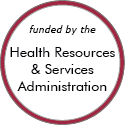Rural Project Examples: Populations
Other Project Examples
Safe Place of Eastern South Dakota
Updated/reviewed November 2025
- Need: To provide victims of domestic violence and sexual assault a safe space, advocacy, education, and family support services.
- Intervention: Safe Place of Eastern South Dakota provides emergency/transitional housing, support and referral services, family visitation services, and community education.
- Results: In 2024, Safe Place of Eastern South Dakota answered 404 crisis calls, provided shelter for 135 survivors, and advocated for 95 survivors.
The Coffee Break Project
Updated/reviewed November 2025
- Need: Men in the agriculture industry face high suicide rates due to factors including long hours, geographic isolation, lack of social opportunities, and stigma surrounding mental health care.
- Intervention: The Coffee Break Project, a program led by Valley-Wide Health Systems, Inc. in southeastern Colorado, encourages mental health check-ins for farmers and ranchers through a public awareness campaign and casual coffee gatherings that utilize COMET, an intervention model developed specifically for rural communities.
- Results: Between eight and 20 people typically attend each coffee gathering.
Lakewood Food Access Initiatives
Updated/reviewed October 2025
- Need: Parts of rural Todd County, Minnesota and surrounding areas are classified as food deserts, where many rural families face food insecurity and low availability of both nutritious and affordable provisions.
- Intervention: A collection of programs address food insecurity and the dietary health of members of the community, from children and families to older adults, supplying them with locally sourced fruits, vegetables, and meat.
- Results: Lakewood Health System conducts around 50,000 food insecurity screenings each year. Fresh produce, meat, and other goods are distributed to roughly 140 families (around 500 individuals), 75 seniors, and 75 school-aged children annually.
Rural Firefighters Delivering Agricultural Safety and Health (RF-DASH)
Updated/reviewed October 2025
- Need: To reduce injuries in agricultural communities and improve emergency responders' preparedness when called to farms and ranches.
- Intervention: RF-DASH equips rural fire/EMS personnel and others with agricultural health and safety knowledge and tools to pre-plan for agricultural emergencies as well as assess and then mitigate agricultural hazards.
- Results: Over 250 firefighters and EMTs have received training to become RF-DASH trainers.
St. Francis Mission Dental Clinic
Updated/reviewed October 2025
- Need: To improve oral health among the residents of the Rosebud Reservation in South Dakota.
- Intervention: St. Francis Mission founded a dental clinic, staffed by volunteers from across the country, to offer free oral healthcare to residents of the Rosebud Reservation.
- Results: The clinic typically offered 20 one-week clinics every year and served 3,000 patients after transitioning to electronic records in 2021.
Implementation of a Nursing Veterans' Initiative to Transform Education (INVITE)

Updated/reviewed September 2025
- Need: To support rural veterans pursuing a career in nursing.
- Intervention: The INVITE program improved the curriculum and reworked admission requirements to better support veteran students' experiences in the College of St. Scholastica undergraduate nursing program.
- Results: The number of veterans pursuing nursing has more than doubled since program implementation, and all students have reported an increased interest in serving rural communities.
Military Medics and Corpsmen Program
Updated/reviewed September 2025
- Need: To help veterans transition into civilian healthcare careers.
- Intervention: MMAC and healthcare employers in urban and rural Virginia provide employment and education opportunities to veterans seeking civilian medical credentials.
- Results: MMAC has been able to help 837 veterans, transitioning service members, and military spouses find healthcare employment.
Project PROMISE
Updated/reviewed September 2025
- Need: An increased interest among young people to pursue a medical career in rural North Carolina
- Intervention: Two medical students started a program that gives high school seniors medical academic training, mentor relationships, and hands-on experience in rural North Carolina facilities.
- Results: Project PROMISE has 40 high school completers, 19 of whom are pursuing an undergraduate degree with an interest in studying medicine. Two students are currently in medical school, with plans to work in a rural area once finished.
Schools as a Hub for Health
Updated/reviewed September 2025
- Need: To improve health outcomes in rural Appalachian Ohio.
- Intervention: Schools as a Hub for Health promoted holistic wellness for the whole community by creating or bringing in programs that support physical, mental, and social health.
- Results: The project gained administrator buy-in and facilitated the development of a variety of health-focused school-based programs.
Age-Friendly and Dementia-Friendly Winnemucca
Updated/reviewed August 2025
- Need: To educate rural community members about Alzheimer's disease and other dementias and to support older adults with dementia and caregivers in need.
- Intervention: A community group formed in Winnemucca, Nevada, to discuss topics like health, housing, social events, community improvement, education, and transportation for older adults. The group also provides outreach to older adults, caregiver support, and a variety of educational activities and events.
- Results: The group's efforts have led to many changes for community welfare and safety as well as opportunities for education and activities.
For examples from other sources, see:
